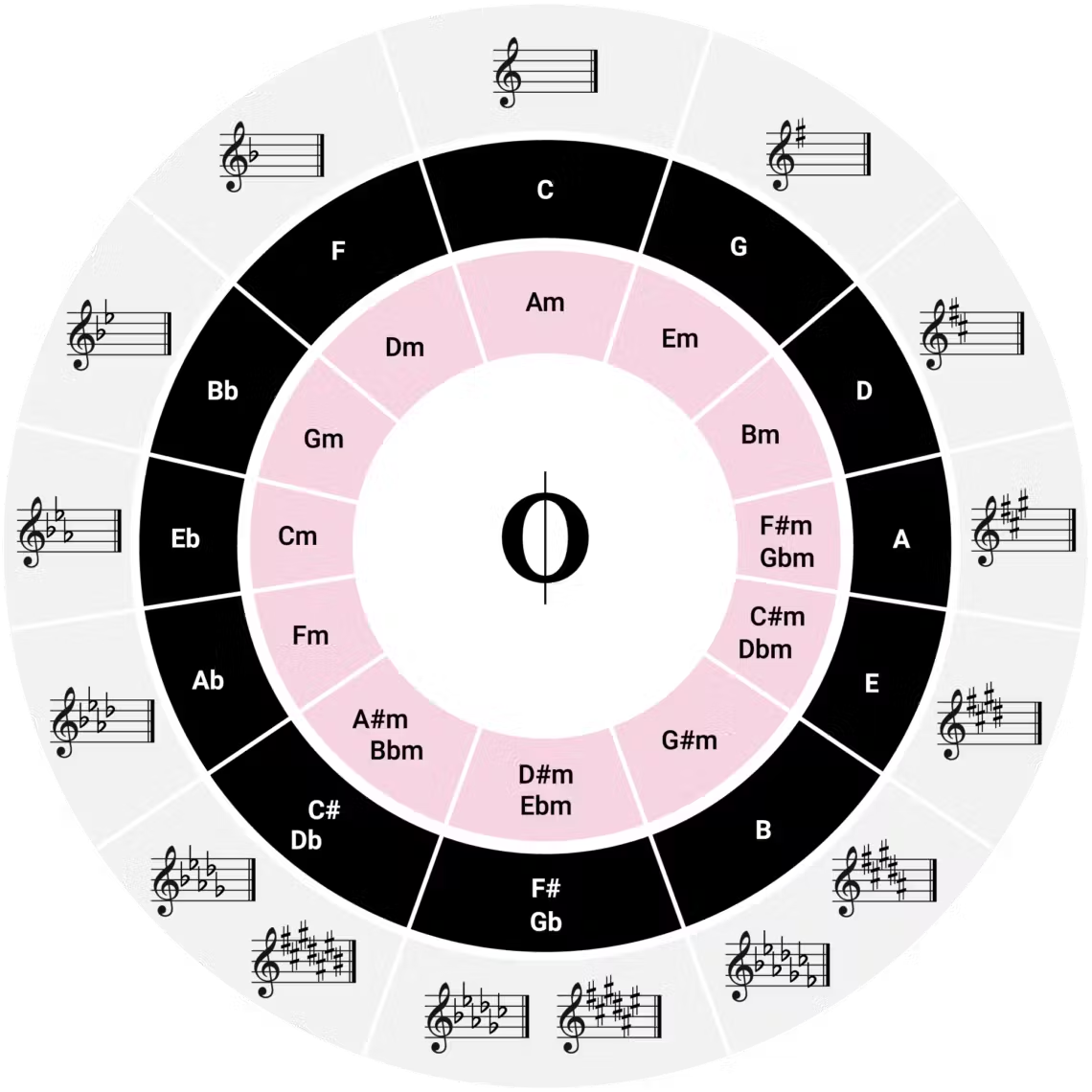The Magic of the Circle of Fifths
Jump to section
You get a fascinating chord poster + exclusive content!
What is the Circle of Fifths?

The Circle of Fifths shows us how all 12 keys or pitches of the chromatic scale relate to one another. It organizes them in a specific order, in a round of perfect fifths if you move clockwise - hence the name. Starting with C we move 5 steps up and reach G, 5 steps more lead to D, and so on, until we make our way back to C again!
If you look at the Circle of Fifths which you can download & print here you'll see 3 circles. Each of these gives us different info:
- the (black) middle ring tells you the major key
- The (pink) inner ring tells you the relative minor key
- The (greyish) outer ring tells you the key signature (of both the major and corresponding minor key).
How to Use the Circle of Fifths
- To know or memorize the key signatures
- To organize or describe the harmonic function of chord progressions or modulations
If you want to learn the key signatures: Look at the outer "ring" of the circle, starting with C Major. You will see that
- C Major has no sharps or flats.
- G Major, the next fifth up if you move clockwise, has got one sharp, F#. The number of sharps increases as we continue in the same direction.
- D Major has got two sharps
- A Major has got 3 sharps
- E Major has got 4 sharps
- B Major has got 5 sharps
- F-sharp Major has got 6 sharps = enharmonic twin: G-flat Major, which has 6 flats
As you continue your round within the circle you switch from an ever-increasing number of sharps to an equally decreasing number of flats.
- D-flat Major has got 5 flats = enharmonic twin: C-sharp Major with 7 sharps
- A-flat Major has got 4 flats = enharmonic twin: G-sharp Major (rarely used)
- E-flat Major has got 3 flats = enharmonic twin: D-sharp Major (rarely used)
- B-flat Major has got 2 flats = enharmonic twin: A-sharp Major (rarely used)
- F-Major has got 1 flat
The relative Minor scales to the Major scales (that share the same key signature) are depicted in the inner pink circle. If you follow it, starting from C/A Minor, this is what you'll come across:
- A Minor shares the key signature of C
- E Minor shares the key signature of G
- B Minor shares the key signature of D
- F-sharp minor shares the key signature of A
- C-sharp Minor shares the key signature of E
- G-sharp Minor shares the key signature of B
- D-sharp Minor = E-flat Minor and shares the key signature of F-sharp Major = G-flat Major
- A-sharp Minor = B-flat Minor and shares the key signature of C-sharp Major = D-flat Major
- F Minor shares the key signature of A-flat Major
- C Minor shares the key signature of E-flat Major
- G Minor shares the key signature of B-flat Major
- D Minor shares the key signature of F Major
If you want to analyze harmonic function, you'll easily find the dominant (V) of each scale/chord by looking at the next one in the circle clockwise, the relative Minor (vi) by looking at the corresponding "pink" circle bit, and the subdominant (IV) by looking counter-clockwise. The ii and iii are simply the minor versions of IV and V!
Chord (I) - (ii) - (iii) - (IV) - (V) - (vi)
- C Major C - Dm - Em - F - G - Am
- G Major G - Am - Bm - C - D- Em
- D Major D - Em - F#m - G - A - Bm
- A Major A - Bm - C#m - D - E - F#m
- E Major E - F#m - G#m - A - B -C#m
- B Major B - C#m - D#m - E - F# - G#m
- F# Major F# - G#m - A#m - B - C# - D#m
- C# Major C# - D#m - E#m - F# - G# - A#m
- Cb Major Cb - Dbm - Ebm - Fb - Gb - Abm
- Gb Major Gb - Abm - Hbm - Cb - Db - Ebm
- Db Major Db - Ebm - Fm - Gb - Ab - Bbm
- Ab Major Ab - Hbm - Cm - Db - Eb - Fm
- Eb Major Eb - Fm - Gm - Ab - Bb - Cm
- Bb Major Bb - Cm - Dm - Eb - F- Gm
Here's a compact overview:

More Ways to Use the Circle of Fifths
The Circle of Fifths can also help you find the basic diatonic major and natural minor scales and their notes.
There's also a clever little way to know what your Major and Minor chords are, using "the triangle" (see below):

For example (see above left) the C-Major chord is constructed of C-E-G. If you follow the same principle and move that triangle to E, the Circle of Fifths tells you it is constructed of E-G#-B. And so on.
The Circle of Fifths in Different Styles of Music
Jazz
In Jazz, you think in chords. The Circle of Fifths makes this easy and helps you quickly find all the chords you need to modulate, improvise, and substitute. In Jazz it is common to work your way from chord to chord using secondary dominants (the fifth of a fifth)! For example, the dominant of C is G. The dominant of G is D, so if you try to move from C to G, a D will make a great pivot chord!
Classical
By far the most famous music written with the Circle of Fifths is Bach’s Well-Tempered Clavier, which has 24 preludes and fugues. It covers all 12 major and 12 minor keys and was specifically written for the purpose of presenting all the keys to students (and their audience).
Folk, Pop, Blues
In Folk, Pop, or Blues, most songs stay in one segment of the Circle following a tight song structure. One of the most popular ones is called the 12-bar blues. It goes as follows:
- 4 bars tonic (I)
- 2 bars subdominant (IV), 2 bars tonic (I)
- 1 bar dominant (V), 1 bar subdominant (IV), 2 bars tonic (I)
For a blues in C, the Circle of Fifths tells you to play:
- C - C - C - C
- F - F- C - C
- G - F- C - C
With a little practice, you will be able to easily determine the chord changes of a song by knowing its starting key.
To sum it up
The Circle of Fifths is basically all the rules of Western Music condensed into one graph. Make sure to understand it well, and it will aid you in becoming a great musician.


